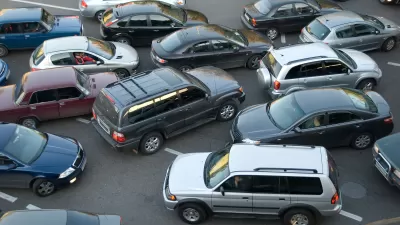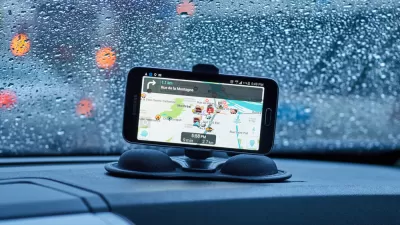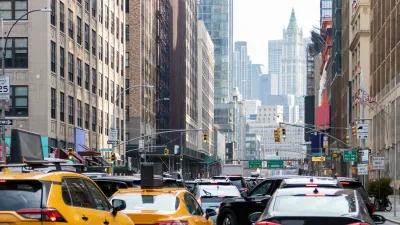Raise your hand if you envisioned a transportation network optimized to full efficiency by navigation apps.

Navigation apps are allowing people to make more selfish decisions while driving, spreading traffic and congestion more evenly throughout the grid. Alexis C. Madrigal's explanation of this troubling outcome of navigation apps like Waze commences with a discussion of selfishness.
In the pre-mobile-app days, drivers’ selfishness was limited by their knowledge of the road network. In those conditions, both simulation and real-world experience showed that most people stuck to the freeways and arterial roads. Sure, there were always people who knew the crazy, back-road route, but the bulk of people just stuck to the routes that transportation planners had designated as the preferred way to get from A to B.
Now, however, a new information layer is destroying the nudging infrastructure that traffic planners built into cities. Commuters armed with mobile mapping apps, route-following Lyft and Uber drivers, and software-optimized truckers can all act with a more perfect selfishness.
A new study by researchers at UC Berkeley’s Institute of Transportation Studies inspires this discussion of a "vastly overlooked" problem. Here's Madrigal's summary of the findings of that study: "In some scenarios, traffic-beating apps might work for an individual, but make congestion worse overall. And autonomous vehicles, touted as an answer to traffic-y streets, could deepen the problem."
Alexandre Bayen, director of UC Berkeley’s Institute of Transportation Studies, is also on video discussing the study's findings, and more about what navigation apps mean for the future of traffic and congestion in cities.
FULL STORY: The Perfect Selfishness of Mapping Apps

Alabama: Trump Terminates Settlements for Black Communities Harmed By Raw Sewage
Trump deemed the landmark civil rights agreement “illegal DEI and environmental justice policy.”

Planetizen Federal Action Tracker
A weekly monitor of how Trump’s orders and actions are impacting planners and planning in America.

The 120 Year Old Tiny Home Villages That Sheltered San Francisco’s Earthquake Refugees
More than a century ago, San Francisco mobilized to house thousands of residents displaced by the 1906 earthquake. Could their strategy offer a model for the present?

In Both Crashes and Crime, Public Transportation is Far Safer than Driving
Contrary to popular assumptions, public transportation has far lower crash and crime rates than automobile travel. For safer communities, improve and encourage transit travel.

Report: Zoning Reforms Should Complement Nashville’s Ambitious Transit Plan
Without reform, restrictive zoning codes will limit the impact of the city’s planned transit expansion and could exclude some of the residents who depend on transit the most.

Judge Orders Release of Frozen IRA, IIJA Funding
The decision is a victory for environmental groups who charged that freezing funds for critical infrastructure and disaster response programs caused “real and irreparable harm” to communities.
Urban Design for Planners 1: Software Tools
This six-course series explores essential urban design concepts using open source software and equips planners with the tools they need to participate fully in the urban design process.
Planning for Universal Design
Learn the tools for implementing Universal Design in planning regulations.
Clanton & Associates, Inc.
Jessamine County Fiscal Court
Institute for Housing and Urban Development Studies (IHS)
City of Grandview
Harvard GSD Executive Education
Toledo-Lucas County Plan Commissions
Salt Lake City
NYU Wagner Graduate School of Public Service





























